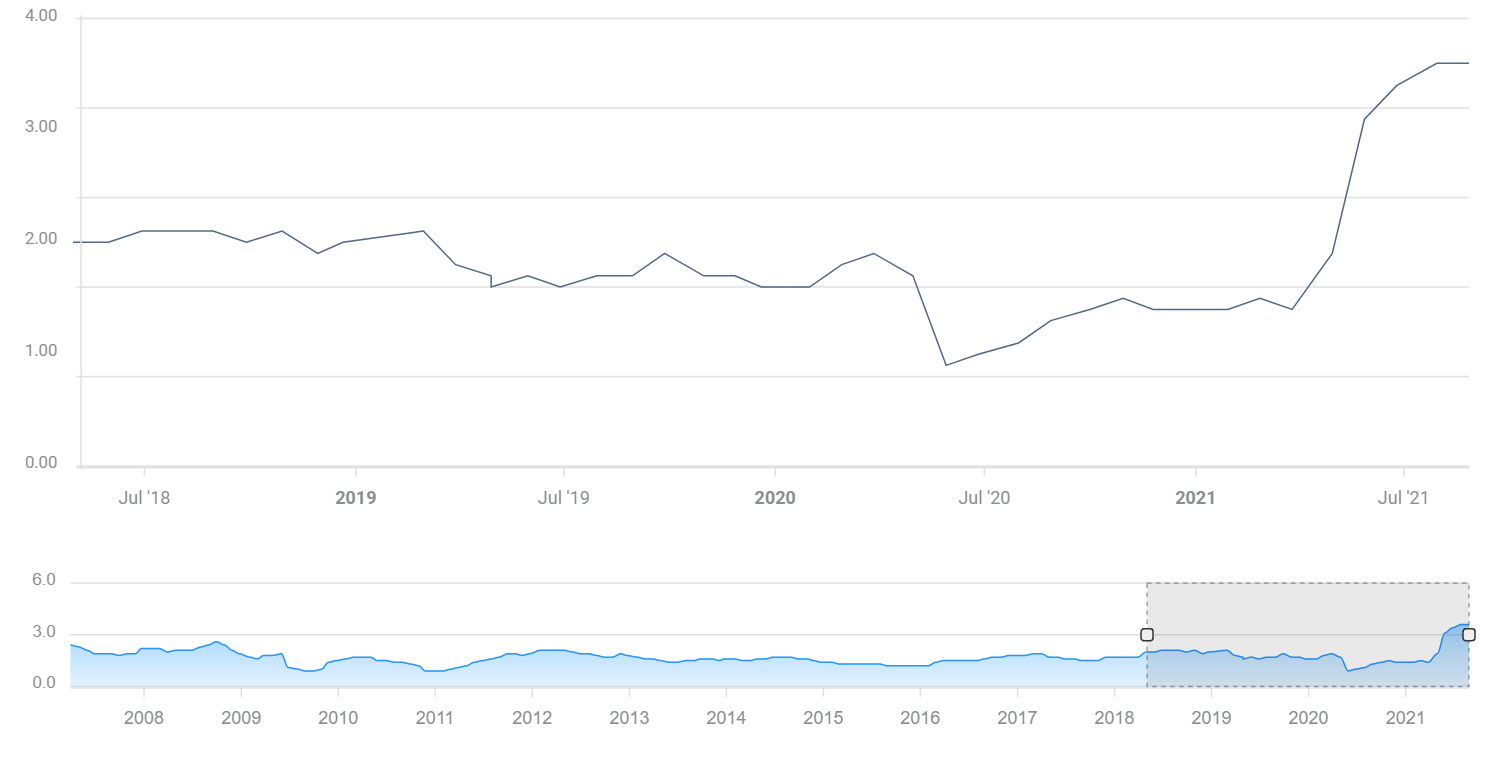- The Core PCE Price Index is set to decrease from 3.6% YoY in August.
- Fed officials watch this measure of inflation to determine policy.
- After the Fed's taper signal, only a sharp drop would stop the dollar.
After walking at the top of one mountain, is it time to begin descending? Mountaineers can look ahead and see the answers, but when it comes to inflation, "cresting" only reflects an opinion. The Core Personal Consumption Expenditure (Core PCE) is the Federal Reserve's preferred gauge of prices. Will it fall?
Core PCE hit 3.6% YoY in June and July but is set to drop in August. The main reason to assume the indicator would retreat is that the parallel Core Consumer Price Index (Core CPI) decelerated from a peak of 4.5% to 4% YoY in August. These separate publications use different methodologies, and CPI is published earlier.
As the chart below shows, Core PCE rarely topped 2% – the Fed's long-term target – before the pandemic struck.
Back in 2020, the bank laid out a new policy targeting average inflation over several years rather than 2% every year. The implication is that prices would be allowed to temporarily surpass 2% in order to compensate for previously low inflation. Officials may have got more than they asked for.
Outcomes and reactions
Core CPI slipped from 4.3% to 4%, indicating a similar retreat in Core PCE – from 3.6% to a range of 3.2% to 3.4%. That would still leave underlying price pressures at high levels, supporting the case for a taper announcement in November. Fed Chair Jerome Powell signaled the bank would announce a reduction in bond-buying in the next meeting.
Even if markets shrug off such an "as expected" result, the dollar could still advance. Apart from tapering, investors are worried about the US debt ceiling and soaring energy prices that could derail the recovery in both Europe and China. The greenback benefits from safe-haven flows in times of trouble.
In case Core PCE surprises with a read of 3.5% or higher – thus hardly budging – the dollar could further advance. Investors would begin factoring in an accelerated taper timeline or perhaps an early rate hike. Powell and his colleagues went to great lengths to explain why reducing bond buys and raising rates are separate events, but markets remain concerned.
The only scenario in which the dollar would fall would be a more significant fall in Core PCE – 3.1% or lower. If price pressures substantially ease, some would speculate that the Fed could have a rethink on tapering in November, potentially pushing it back to December. It is essential to note that Core CPI surprised to the downside.
In that case, the greenback could decline across the board, as it would cause a considerable rethink.
Conclusion
The Fed's favorite inflation gauge is set to retreat, yet it would take a substantial plunge to turn the dollar down amid safe-haven flows.
Information on these pages contains forward-looking statements that involve risks and uncertainties. Markets and instruments profiled on this page are for informational purposes only and should not in any way come across as a recommendation to buy or sell in these assets. You should do your own thorough research before making any investment decisions. FXStreet does not in any way guarantee that this information is free from mistakes, errors, or material misstatements. It also does not guarantee that this information is of a timely nature. Investing in Open Markets involves a great deal of risk, including the loss of all or a portion of your investment, as well as emotional distress. All risks, losses and costs associated with investing, including total loss of principal, are your responsibility. The views and opinions expressed in this article are those of the authors and do not necessarily reflect the official policy or position of FXStreet nor its advertisers. The author will not be held responsible for information that is found at the end of links posted on this page.
If not otherwise explicitly mentioned in the body of the article, at the time of writing, the author has no position in any stock mentioned in this article and no business relationship with any company mentioned. The author has not received compensation for writing this article, other than from FXStreet.
FXStreet and the author do not provide personalized recommendations. The author makes no representations as to the accuracy, completeness, or suitability of this information. FXStreet and the author will not be liable for any errors, omissions or any losses, injuries or damages arising from this information and its display or use. Errors and omissions excepted.
The author and FXStreet are not registered investment advisors and nothing in this article is intended to be investment advice.
Recommended Content
Editors’ Picks

EUR/USD trades sideways below 1.0450 amid quiet markets
EUR/USD defends gains below 1.0450 in European trading on Monday. Thin trading heading into the Xmas holiday and a modest US Dollar rebound leaves the pair in a familair range. Meanwhile, ECB President Lagarde's comments fail to impress the Euro.

GBP/USD stays defensive below 1.2600 after UK Q3 GDP revision
GBP/USD trades on the defensive below 1.2600 in the European session on Monday. The pair holds lower ground following the downward revision to the third-quarter UK GDP data, which weighs negatively on the Pound Sterling amid a broad US Dollar uptick.

Gold price holds comfortably above $2,600 mark; lacks bullish conviction
Gold price oscillates in a range at the start of a new week amid mixed fundamental cues. Geopolitical risks continue to underpin the XAU/USD amid subdued US Dollar price action. The Fed’s hawkish stance backs elevated US bond yields and caps the pair’s gains.

The US Dollar ends the year on a strong note
The US Dollar ends the year on a strong note, hitting two-year highs at 108.45. The Fed expects a 50-point rate cut for the full year 2025 versus 4 cuts one quarter earlier, citing higher inflation forecasts and a stubbornly strong labour market.

Bank of England stays on hold, but a dovish front is building
Bank of England rates were maintained at 4.75% today, in line with expectations. However, the 6-3 vote split sent a moderately dovish signal to markets, prompting some dovish repricing and a weaker pound. We remain more dovish than market pricing for 2025.

Best Forex Brokers with Low Spreads
VERIFIED Low spreads are crucial for reducing trading costs. Explore top Forex brokers offering competitive spreads and high leverage. Compare options for EUR/USD, GBP/USD, USD/JPY, and Gold.
